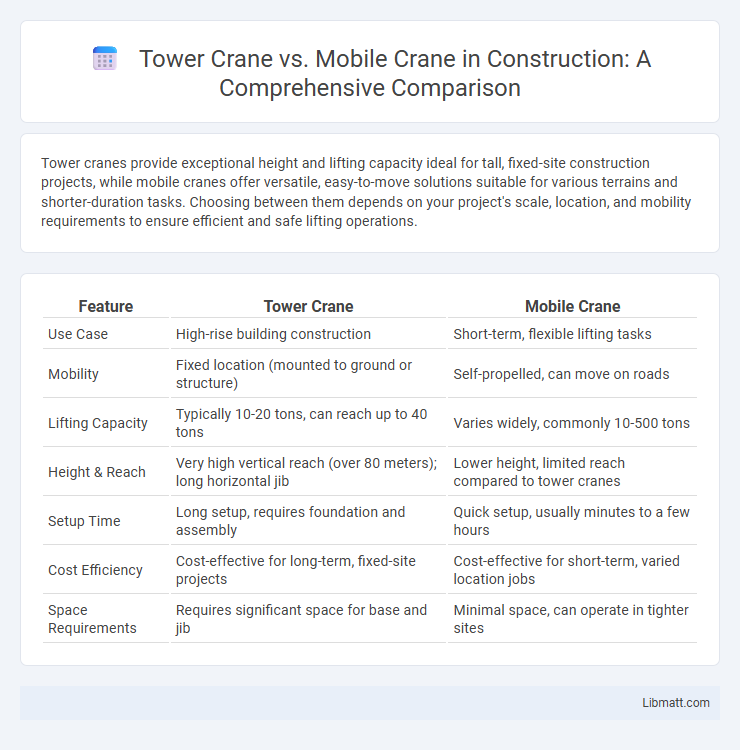Tower cranes provide exceptional height and lifting capacity ideal for tall, fixed-site construction projects, while mobile cranes offer versatile, easy-to-move solutions suitable for various terrains and shorter-duration tasks. Choosing between them depends on your project's scale, location, and mobility requirements to ensure efficient and safe lifting operations.
Table of Comparison
| Feature | Tower Crane | Mobile Crane |
|---|---|---|
| Use Case | High-rise building construction | Short-term, flexible lifting tasks |
| Mobility | Fixed location (mounted to ground or structure) | Self-propelled, can move on roads |
| Lifting Capacity | Typically 10-20 tons, can reach up to 40 tons | Varies widely, commonly 10-500 tons |
| Height & Reach | Very high vertical reach (over 80 meters); long horizontal jib | Lower height, limited reach compared to tower cranes |
| Setup Time | Long setup, requires foundation and assembly | Quick setup, usually minutes to a few hours |
| Cost Efficiency | Cost-effective for long-term, fixed-site projects | Cost-effective for short-term, varied location jobs |
| Space Requirements | Requires significant space for base and jib | Minimal space, can operate in tighter sites |
Introduction to Tower Cranes and Mobile Cranes
Tower cranes are fixed, tall structures primarily used in the construction of high-rise buildings, providing a high lifting capacity and extensive reach for heavy materials. Mobile cranes offer the advantage of portability and flexibility, making them ideal for various construction sites and lifting tasks due to their ability to move freely and quickly. Your choice between a tower crane and a mobile crane depends on project scale, site constraints, and the specific lifting requirements.
Key Differences Between Tower and Mobile Cranes
Tower cranes are fixed structures commonly used for high-rise construction, offering significant height and lifting capacity, while mobile cranes provide flexibility with their ability to move around the job site easily. The key differences lie in their mobility, setup time, and load capacity; tower cranes require a longer setup but handle heavier loads at greater heights, whereas mobile cranes excel in versatility and quick deployment but usually have lower lifting limits. Understanding these distinctions helps optimize your equipment choice based on project size, location, and lifting requirements.
Structural Features and Design Comparison
Tower cranes feature a fixed vertical mast and long horizontal jib, providing high lifting capacity and extended reach for tall building construction, while mobile cranes offer a versatile design with a telescoping boom mounted on a truck or crawler, enabling easy movement and rapid setup on various job sites. Tower cranes are designed for stability and height, anchored to the ground or a building structure, whereas mobile cranes prioritize maneuverability with hydraulic systems and adjustable counterweights for balanced lifting operations. Your choice depends on the specific project needs, balancing the structural advantages of tower cranes against the flexible design and transportability of mobile cranes.
Mobility and Site Flexibility
Tower cranes offer limited mobility as they are fixed to a specific location, making them ideal for long-term projects with vertical lifting needs. Mobile cranes provide superior site flexibility, easily relocating across different areas and handling a variety of lifting tasks on uneven terrain. Your choice depends on whether your project demands stationary precision or versatile movement.
Load Capacity and Lifting Height
Tower cranes typically offer higher load capacities ranging from 10 to 20 tons and can reach lifting heights exceeding 80 meters, making them ideal for tall building construction. Mobile cranes provide versatile load capacities between 5 to 100 tons with maximum lifting heights usually up to 40 meters, suitable for shorter, more flexible lifting tasks. Choosing the right crane depends on your specific project requirements for load capacity and lifting height to ensure efficiency and safety.
Setup, Assembly, and Disassembly
Tower cranes require extensive setup involving the construction of a stable concrete foundation and precise assembly of the tower sections, often necessitating specialized labor and significant time. Mobile cranes offer quick setup and assembly due to their self-contained design and hydraulic outriggers, enabling rapid deployment and flexibility on various job sites. Your choice depends on project scale and mobility needs, as tower cranes excel in long-term, high-rise construction, while mobile cranes prioritize efficiency and ease of transport.
Ideal Use Cases in Construction Projects
Tower cranes excel in high-rise construction projects where lifting heavy materials to great heights is essential, providing stability and a large operational radius. Mobile cranes are ideal for short-term tasks requiring quick setup and flexibility, such as material transport and assembly in confined or uneven sites. Your choice depends on project scale, site conditions, and the required lifting capacity.
Safety Considerations for Both Crane Types
Tower cranes and mobile cranes each present unique safety considerations critical for construction site operations. Tower cranes require rigorous inspection of structural integrity and secure anchorage to prevent collapse or tipping, while mobile cranes demand careful assessment of ground conditions and load stability due to their mobility. You must ensure operator training and adherence to safety protocols for both crane types to minimize risks and safeguard personnel and property.
Cost Factors and Operational Efficiency
Tower cranes typically involve higher initial costs due to their complex setup, but offer greater operational efficiency on tall building projects by providing consistent lifting capacity and reach. Mobile cranes have lower upfront expenses and flexibility for varied job sites, though they may experience reduced efficiency on large-scale, repetitive lifting tasks. Your project's budget and site requirements will determine the most cost-effective and efficient crane option.
Choosing the Right Crane for Your Project
Selecting the right crane depends on project scale, site conditions, and lifting requirements; tower cranes excel in high-rise construction with fixed, tall structures, offering superior height and load capacity. Mobile cranes provide greater flexibility and mobility for varied terrain and shorter-term projects, enabling faster setup and relocation. Evaluating factors such as load weight, operational radius, and space constraints ensures optimal crane choice for efficiency and safety.
Tower crane vs Mobile crane Infographic

 libmatt.com
libmatt.com